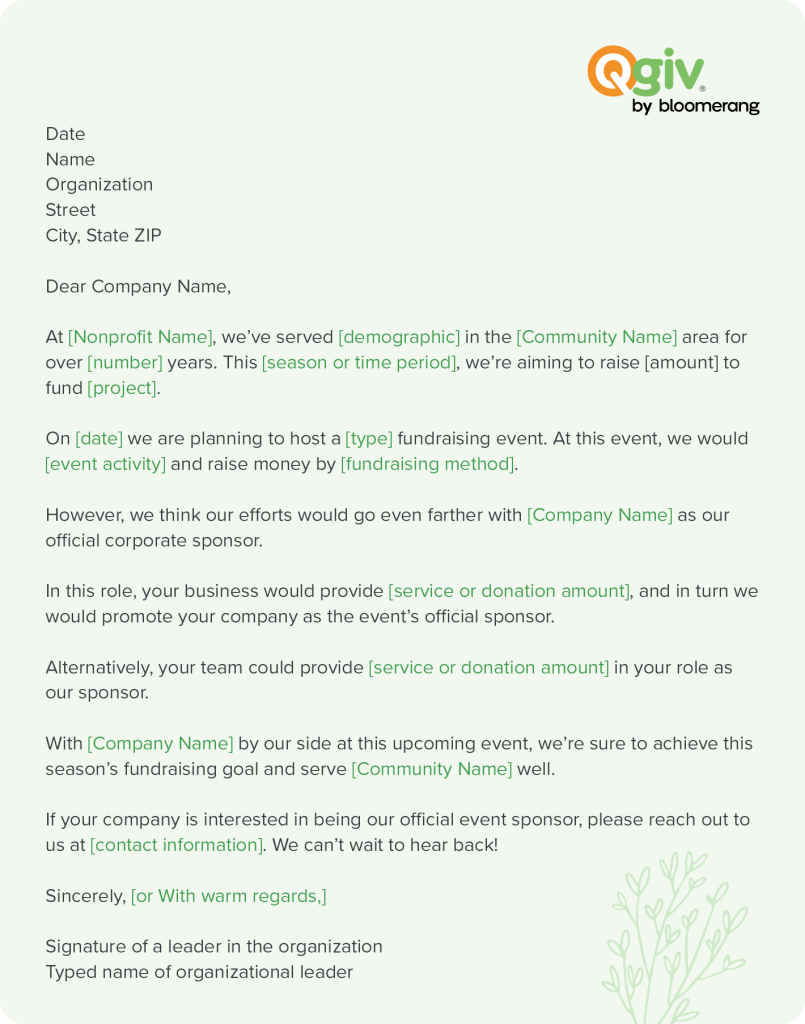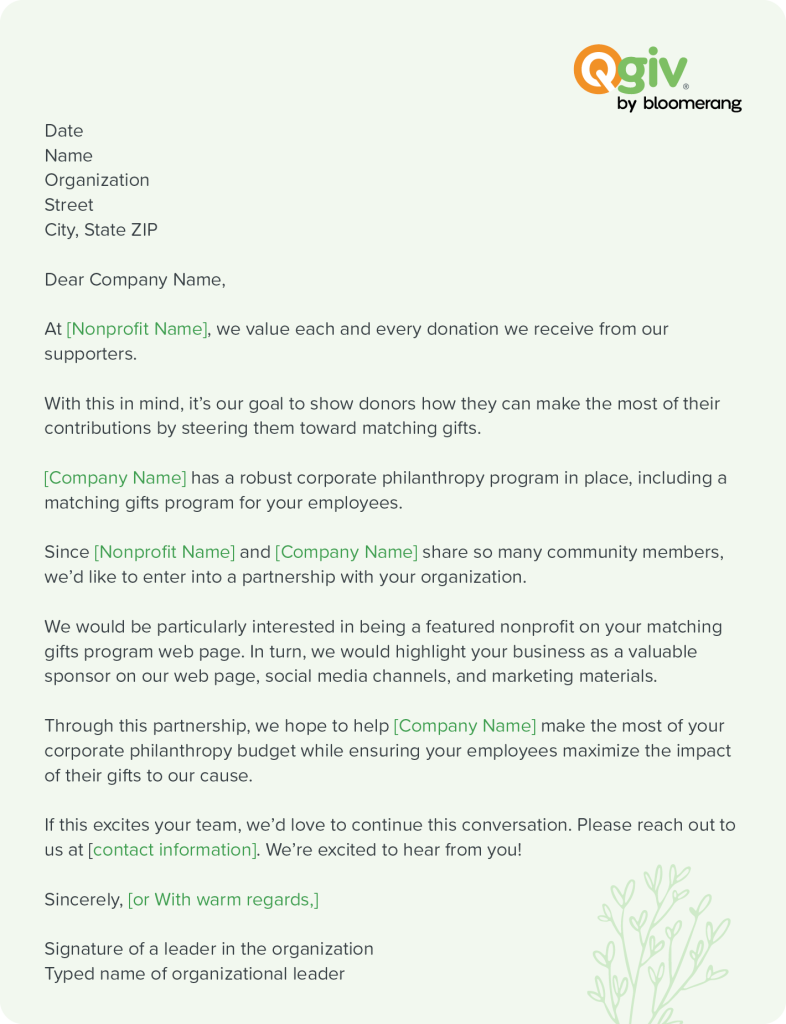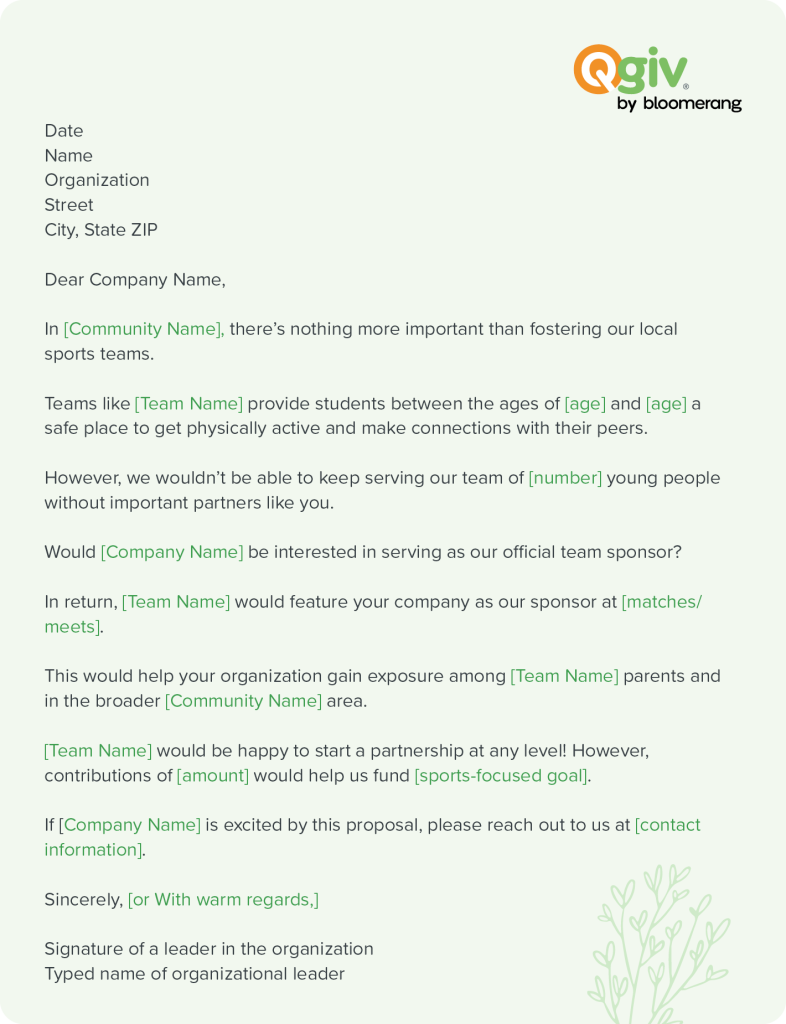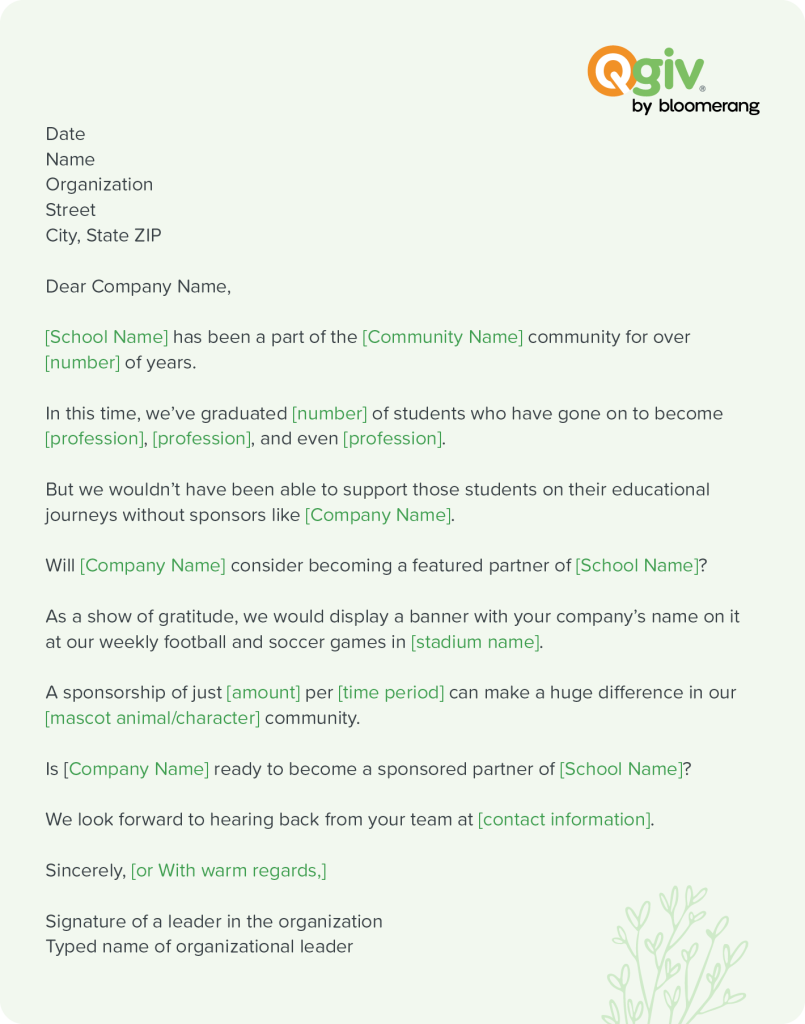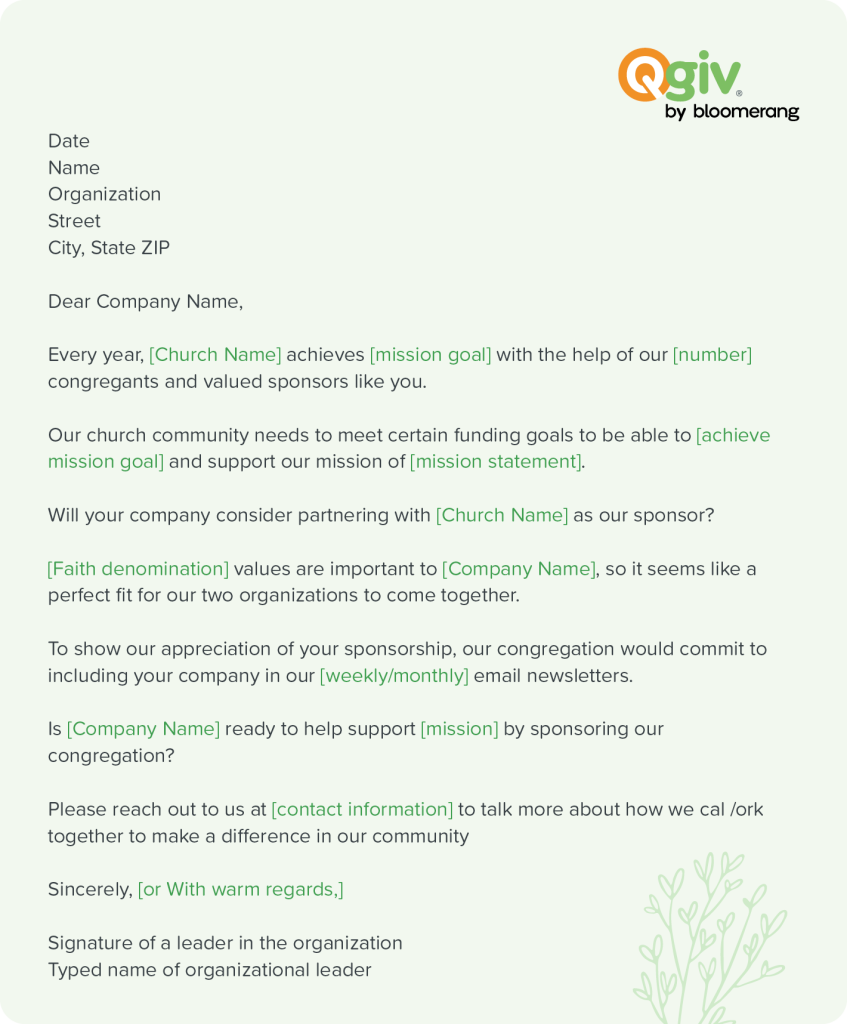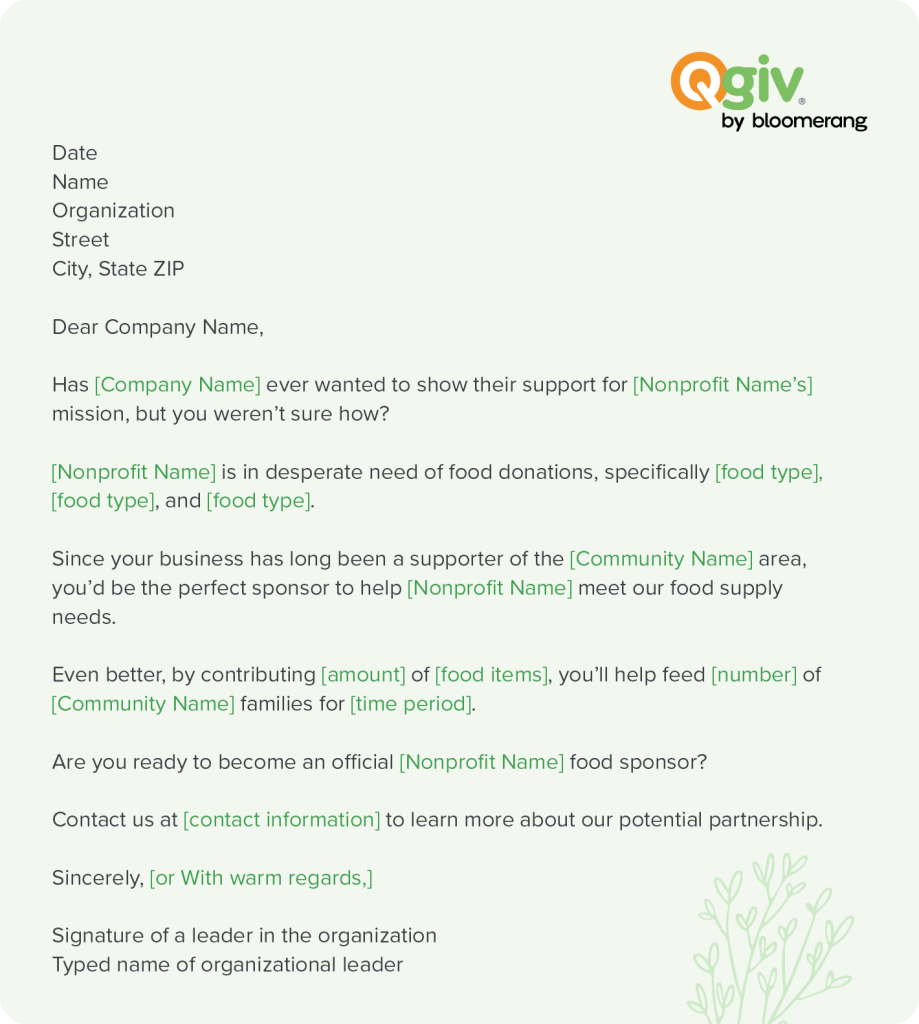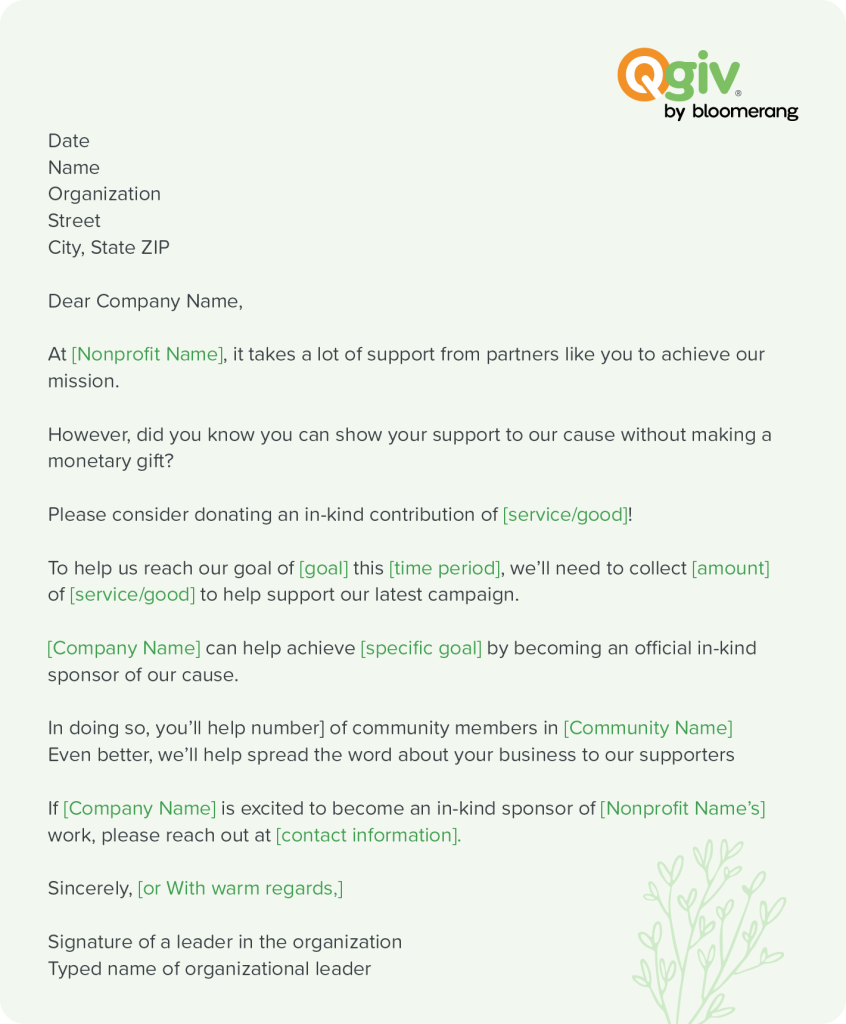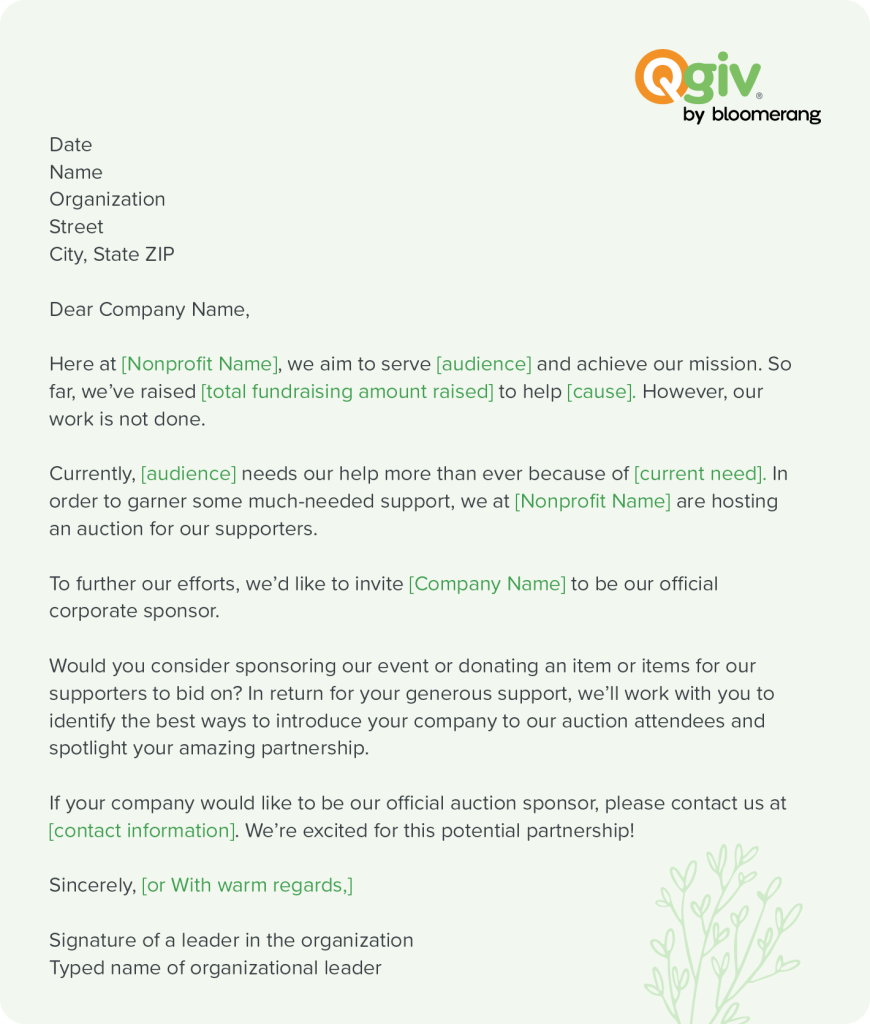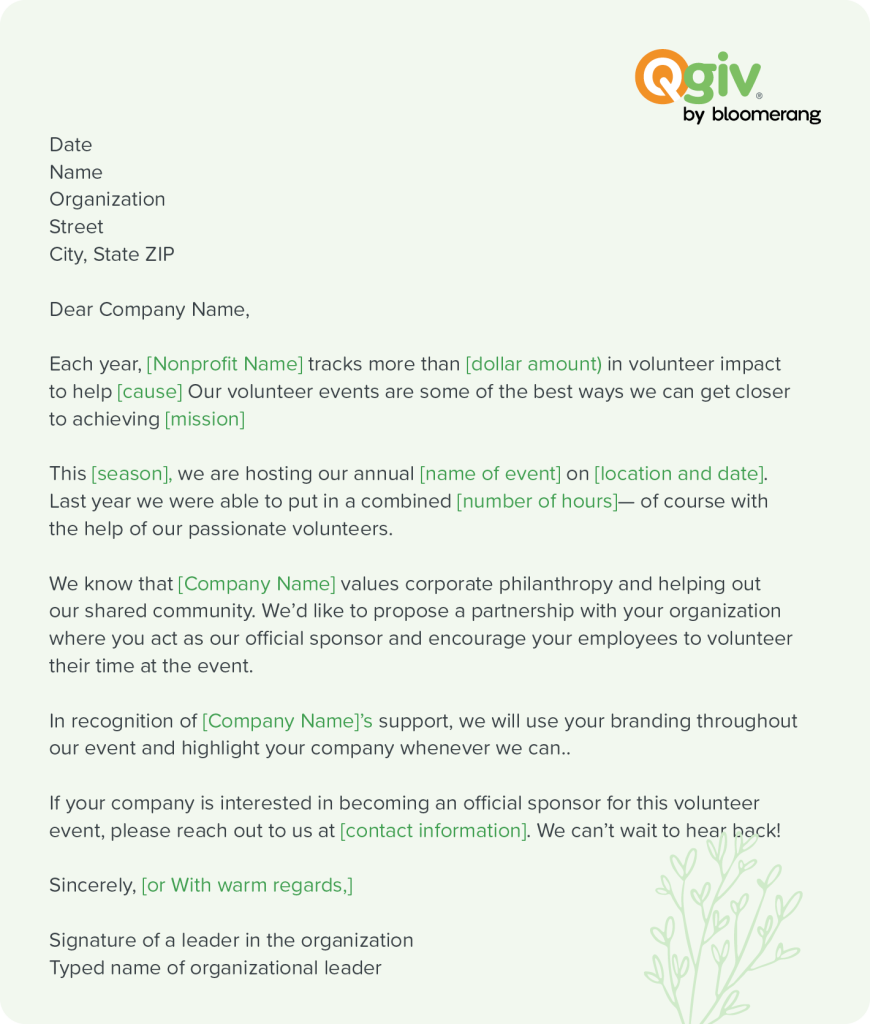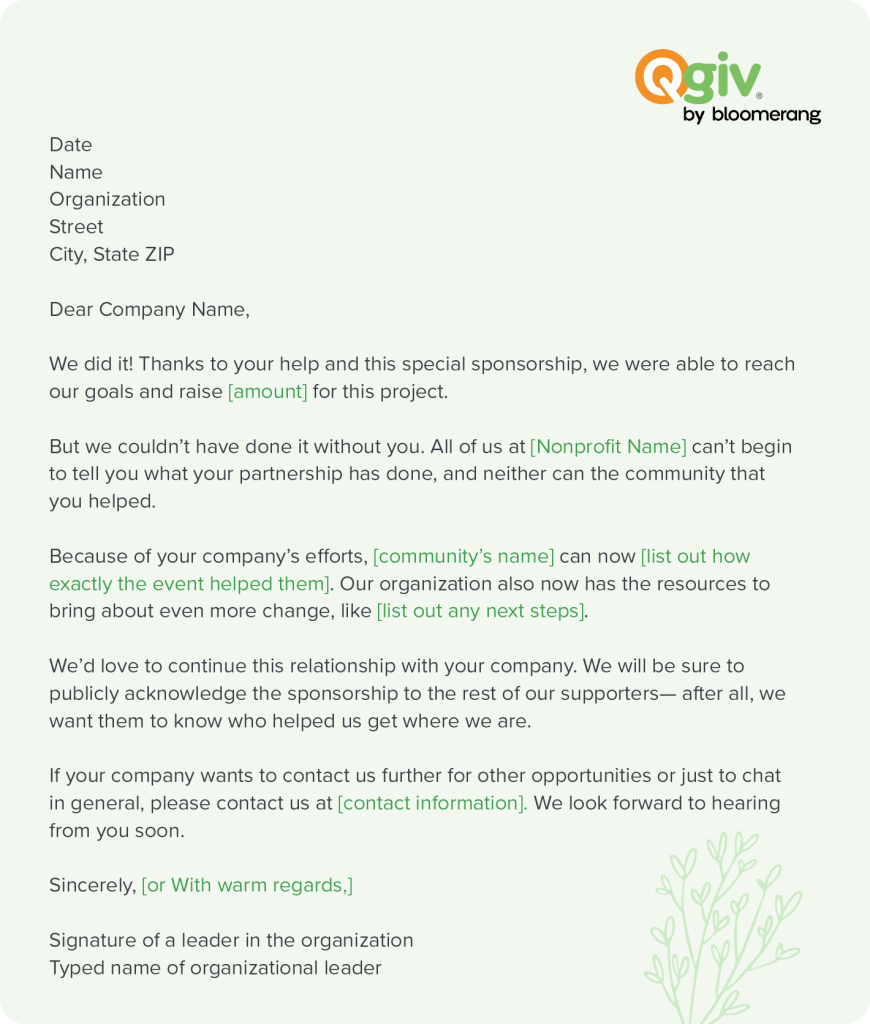With global corporate sponsorship value expected to reach $189.5 billion by 2030, securing sponsorships with for-profit partners is one of the most important steps you can take to reach your fundraising goals. Sponsorship letters empower you to start a conversation about forming a mutually beneficial partnership between your nonprofit and a potential sponsor, and the right sponsorship letter templates make the process easy.
This guide will equip you to secure a sponsor for your next campaign by covering the following:
- Nonprofit sponsorship letters FAQs
- Benefits of sponsorships
- Elements of a sponsorship letter
- 15 nonprofit sponsorship letter templates
- Nonprofit sponsorship letter best practices and tips
- Other ways to promote sponsorship opportunities
Nonprofit sponsorship letters FAQs
What are nonprofit sponsorship letters?
Nonprofit sponsorship letters are a key tool to initiate and nurture collaborative relationships with potential sponsors. These personalized letters outline your nonprofit’s mission, programs, and the benefits sponsors can expect in return for their support.
They offer a direct invitation for corporate partners to become valued contributors to the cause, effectively communicating your organization’s value proposition and paving the way for meaningful partnerships that drive positive change.
What can nonprofits offer in return for a sponsorship?
In exchange for a sponsorship, your organization can offer a few benefits to for-profit partners. One of the main benefits you can offer in return for a sponsorship is advertising opportunities. Whether it’s a banner at an event, a feature on your donation website, or their logo on any t-shirts you sell, sponsorships are a great way for the for-profit world to reach new audiences with your donor base.
What is the difference between a nonprofit sponsorship and a corporate donation?
Here are some of the key differences between a nonprofit sponsorship and a corporate donation:
Nonprofit sponsorships
In a nonprofit sponsorship, the sponsor offers financial aid or services to nonprofits in exchange for promotional benefits like acknowledgment in marketing materials or visibility at events. This partnership fosters a mutually beneficial relationship centered on shared values and goals.
Corporate donations
On the other hand, a corporate donation involves a straightforward philanthropic contribution from a company or individual to a nonprofit without expecting promotional benefits. The donor’s commitment to social responsibility and community engagement typically drives these monetary or in-kind donations.
Who should nonprofits ask for sponsorships?
When looking for potential sponsors, research individuals or organizations aligned with your campaign. These can be local businesses, larger corporations, community organizations, philanthropic foundations, or individuals interested in supporting your mission.
Benefits of sponsorships
Here are a few key benefits of sponsorships for your nonprofit:
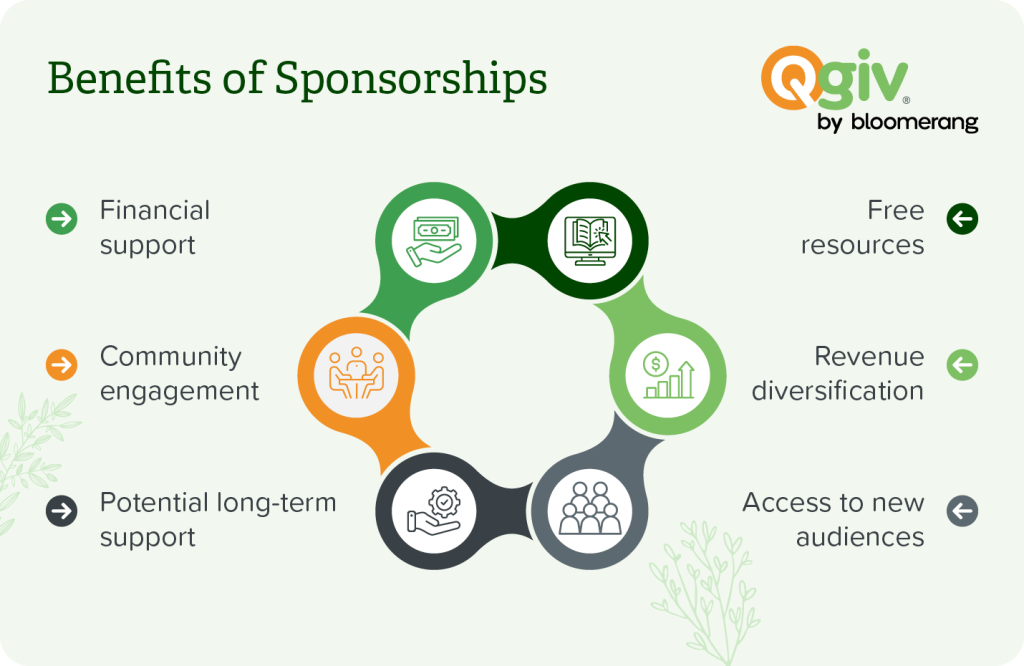
- Financial support. Sponsors often provide funds to cover campaign expenses, from venue rentals to equipment, allowing you to allocate the money you would’ve spent on these costs to more mission-critical activities.
- Free resources. Alternatively, a business may provide in-kind support so your nonprofit can unlock necessary resources for free. For instance, a catering company may provide food at your next fundraising event free of charge.
- Revenue diversification. The more revenue sources you have, the more financially stable your organization will be. Sponsorships are a strong revenue stream that can help you reduce dependence on individual donors and other revenue sources.
- Access to new audiences. Just as you can promote your sponsors, they can also share your organization with their audiences, helping you expand your donor base. When you work with a business with similar values to your nonprofit, you can tap into an audience likely to support your mission. For example, an environmental conservation nonprofit may partner with a plant store.
- Potential long-term support. Successful sponsorships can lead to ongoing collaborations beyond your initial campaign, making your fundraising efforts more sustainable. Plus, when you find trusted corporate partners, you can work together seamlessly and continue enriching each other’s organizations.
- Community engagement. Sponsorships with local businesses or community organizations can help you further connect with your community and spread your mission. While it’s true that larger companies can typically offer more substantial support in the form of larger donations, small local businesses are often the fiercest nonprofit supporters. Don’t overlook these establishments in your efforts to find loyal event sponsors.
Additionally, sponsorships provide various benefits for companies, including increased exposure to the community, positive publicity, and the ability to bolster corporate social responsibility (CSR) programs.
Elements of a sponsorship letter
When writing your sponsorship letters, you don’t want to miss any important details. Here are some key elements to include when writing your sponsorship request letters:
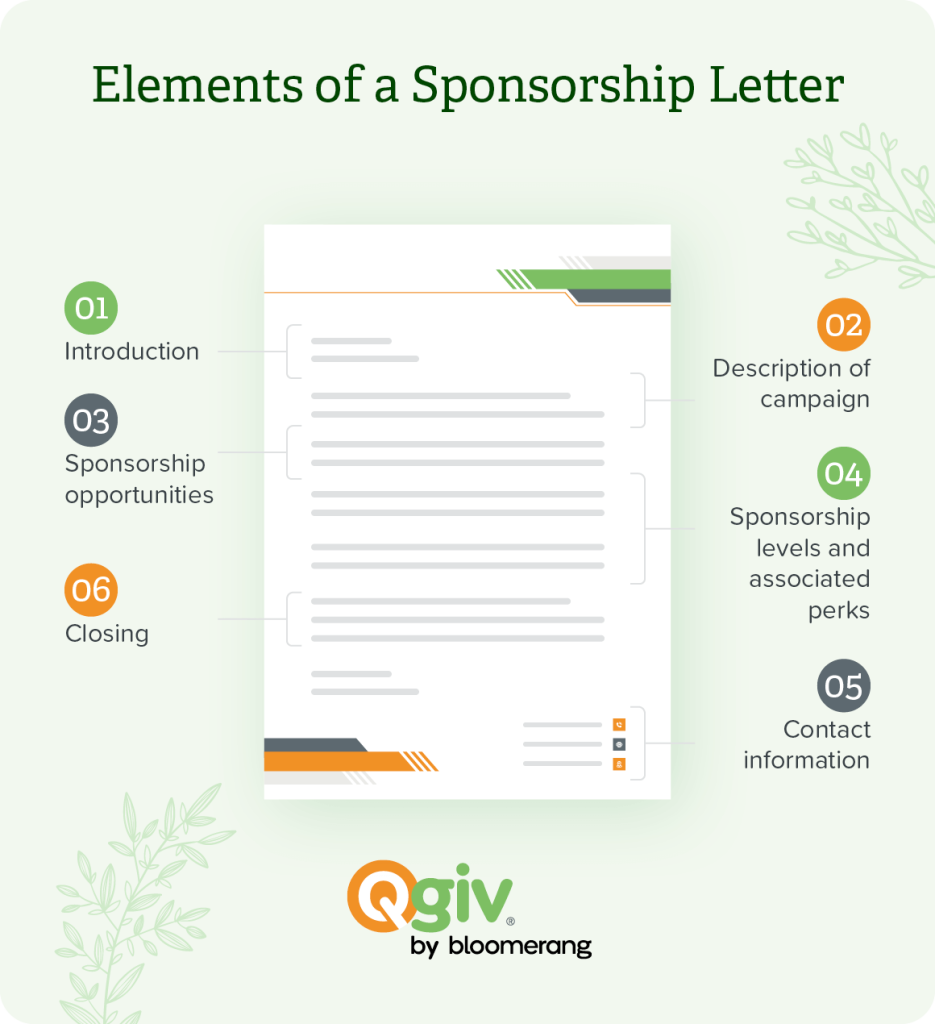
- Introduction. Start by addressing the company and providing a quick introduction to your nonprofit. Summarize your mission, organizational background, and audience demographics so potential partners can learn more about your nonprofit and why its work is important.
- Description of campaign. Next, highlight the campaign you’d like them to support. Explain the type of campaign and what you hope to achieve through this initiative.
- Sponsorship opportunities. Let potential sponsors know the exact type of support you’re looking for. For instance, you may need a certain donation amount, supplies, equipment, or services.
- Sponsorship levels and associated perks. Describe what you’ll offer sponsors in exchange for their contributions. If you offer different sponsorship levels, explain what each level entails.
- Contact information. Include the name and contact information for your nonprofit’s primary sponsorship point of contact so interested companies can easily reach out to you and start discussing opportunities.
- Closing. End the letter by thanking the company for their time and consideration. Include the signature of one of your nonprofit’s leaders.
15 nonprofit sponsorship letter templates
Here are 15 sponsorship letter templates you can customize to fit your mission!
1. Sponsorship letter for events
As you plan your next fundraising campaign, consider enlisting a business to sponsor one of your fundraising or donor stewardship events. Your sponsor could provide staff to help execute the event, pay for the venue, or offset the catering costs.
In your sponsorship request letter, offer them a few ways to show their support for your cause at your next event and include details about how they’ll benefit from their sponsorship. Consider offering perks like adding their logo to event signage, giving them shoutouts during event programming, and providing complimentary tickets for their staff.
Check out this event sponsorship proposal template to inspire your team:
Depending on your nonprofit’s needs, not all event sponsorships will be appropriate. For example, an animal advocacy group might think twice about soliciting sponsorships from their local meat-packing plant, or a nature conservancy might reconsider partnering with a large development company.
Another tip? Enlisting a corporate sponsor for a peer-to-peer fundraising event is a great way to tap into the company’s audience of potential donors before the event begins. This way, you can maximize the benefit of your partnership in the time leading up to your anchor event.
2. Corporate sponsorship letter
A traditional corporate sponsorship involves a business signing on as a nonprofit’s sponsor for a set time period. One of the best ways to partner with a corporate sponsor for the long term is to have them promote your cause to employees engaging in their matching gifts program.
The sponsor could include a reference to your cause on their corporate philanthropy page or agree to match gifts to your organization at a higher ratio than gifts to other causes. In exchange, your nonprofit would include their business as a valued sponsor on your website.
Consider this corporate sponsorship letter sample that emphasizes a matching gifts partnership:
Many corporations have philanthropy programs that allocate a certain percentage of their overall budgets to charitable contributions, including matching employee gifts. These businesses already have the money set aside to sponsor your cause, but they’re just waiting for an organization like yours to initiate your partnership.
Don’t leave that funding on the table! By proactively sending letters like these, your team automatically boosts your chances of securing a corporate sponsorship and tapping into philanthropic giving budgets.
3. Sponsorship letter for sports
Whether you’re raising money for an adult sports team at the rec center or a K-12 school league, nearly all sports organizations need to raise money at some point to help fund their operations. Some do this with sports fundraisers, while others focus on getting sponsors to support them.
Establishing partnerships with companies your team inspires is a smart way to gain lasting funding while showing love back to a local business.
Try this sponsorship request letter sample the next time your team extends an invitation for a partnership:
Securing a sponsor for your sports team is one of the best ways to fundraise for your organization sustainably. Your team can offer potential sponsors a dedicated banner at your games, a special appreciation message in your opening announcements, or even a spotlight on your social media profiles.
Once your team has an official sponsor, they’re unlikely to leave your partnership. Since sports teams are fixtures of their communities, your sponsor will appreciate the ongoing platform to promote their business.
4. Sponsorship letter for schools
Partnering with a business to be your school’s fundraising sponsor can be simple with the right sponsorship letter strategy. To get started, you’ll need to clearly show your potential sponsor why your school is worth supporting and how a school sponsorship can benefit their business.
Since a large portion of your community has ties to your school (either as parents, students, or alumni), your partnership would have a lot of advertising value for a business.
Make your proposal using a school sponsorship letter like the one below that clearly shows your potential sponsor why this partnership is right for their business:
Just like a sports team, your school can offer your sponsor advertising space in high-traffic areas of your campus. Alternatively, you might list them as your top club sponsor in your school’s yearbook or newspaper. Whatever you decide, emphasize that your sponsor will grow awareness among multiple generations of your community, both parents and students alike.
Since most schools don’t have a big budget for sponsorships, you’ll need to ensure your potential sponsor understands the intrinsic value of your partnership so they consider supporting your school a worthy investment.
5. Church sponsorship letter
Fundraising for your church can be a challenge. Even though your congregation tithes every Sunday, those contributions aren’t always enough to help support the operational costs of your church and fund projects like mission trips. That’s why looking for a sponsor to help address your funding needs can come in handy!
After all, there are likely local business leaders in your area who attribute their success to their faith, and some of them might even attend your church! And just like everyone else, these leaders look for ways to give back to their communities, including their faith communities.
Faith-driven companies may love the opportunity to support a church and assist in growing your congregation, but if you don’t ask them directly, they may not know there’s a need.
Try sending out sponsorship request letters like the template below to inspire potential partners:
Many prospective church sponsors will be inspired to show their support without receiving any “reward” in return. However, if you’re asking for a business to sponsor an event, there are always ways you can thank them for their support, whether that’s by including a link to their website or publicly thanking them on social media.
You can also ask a sponsor to contribute a short inspirational video or statement showing why they chose to sponsor the event. The video should introduce the person and the name of their company, but the entire focus should be on their faith and why they chose to give to the campaign.
6. Food donation request letter
Whether your nonprofit is a family shelter, a faith-based charity, or even a school, sometimes you need to raise donations for specific goods instead of raising money. A common example of this is accepting food donations.
Many nonprofit organizations ask their supporters to donate shelf-stable food like soup, cereal, peanut butter, and more. You might then add the food to your nonprofit’s community pantry or donate it to another organization with a pressing need for these staples.
However, your nonprofit doesn’t need to rely solely on typical donors to provide these much-needed food supplies. You can also ask a sponsor to make an in-kind donation of food items.
Check out this sponsorship letter template that asks for a food donation:
Reach out to local businesses like supermarkets and restaurants to provide sponsored gifts of food to your nonprofit. Alternatively, you might send your letter to a company outside the food service industry. They might purchase foodstuffs for your cause, or they can hold a donation drive at their headquarters to gather supplies.
Offering an invitation for a food sponsorship can be a great way to garner support from a sponsor who isn’t ready to make a large monetary contribution. Not every business has a budget for philanthropy, but food donations can be a great way to show support without breaking the bank.
7. In-kind sponsorship letter
Your nonprofit can propose a sponsorship in which your partner provides in-kind contributions of all sorts of goods. Sponsored partnerships of in-kind gifts are a great way to make sponsorship more accessible for smaller businesses and more convenient for companies of all sizes. You may even be able to find a partner who already produces the goods you need so that you can cut out the middleman.
Before you send your sponsorship request letter, determine what kind of goods or supplies your nonprofit needs to achieve its goals. For instance, maybe you need someone to contribute manpower for a building project or contribute school supplies for a summer camp.
Use this in-kind sponsorship request letter template to get inspired:
Since the sponsor supplies the resources you need, you can redirect money you’d spend on those supplies to other projects. In-kind sponsorships can also make it easier for nonprofits to propose a sponsorship later on, in which your partner provides direct monetary contributions. You’ll already have an established relationship, which means they’ll be more likely to say yes!
8. Auction item sponsorship letter
The magic of a successful auction event lies in the items procured for it. Consider proposing a sponsorship in which a partner provides items for your event. Instead of finding great auction items from various sources, a carefully chosen sponsor can do this for you!
Many local businesses or even larger companies are likely willing to sponsor your auction, especially since it might bring them more business in the future. If your donors like the products/items they won, they’ll be more likely to purchase them again.
Consider using this auction item sponsorship letter template below:
A sponsorship like this can benefit both parties. Your sponsor gets to highlight their support of your nonprofit, your auction attendees get to bid on fun and exciting items, and you can make your auction as successful as possible.
9. Volunteer sponsorship request letter
Consider proposing a sponsorship where your partner incentivizes employees to volunteer for your organization. Some companies even have a dedicated corporate volunteer program in which the employer also donates a set amount when employees meet certain volunteer hours.
Here is a sponsorship letter template for requesting volunteers:
Seeking out volunteers from a sponsor is also a great way to engage with prospective future supporters. Perhaps they’ll volunteer for your cause and connect with your mission. Follow up after the volunteer event with a well-thought-out thank you and a summary of their hard work.
10. Sponsorship acknowledgment letter
Once your event or initiative ends, acknowledge your sponsors and thank them for their generous support to maintain your positive relationship and leave room for future engagement down the line.
When thanking your sponsors, summarize not only how they helped your event but also how they impacted your cause. Clearly defining impact with concrete numbers and examples is a great way to show sponsors they genuinely made a difference and connect them more deeply to your mission.
Check out this sponsorship acknowledgment letter template:
Thanking your sponsors shows them you value their contributions and can help motivate them to sponsor your organization again. This appreciation can help build long-lasting relationships that boost your fundraising efforts sustainably!
11. Community outreach sponsorship letter
This type of letter targets local businesses or organizations to sponsor community-focused initiatives or programs. In your letter, focus on the good you’re doing in the community and how these companies can further their corporate social responsibility (CSR) efforts by partnering with your organization.
Your community outreach sponsorship letter may look something like this:
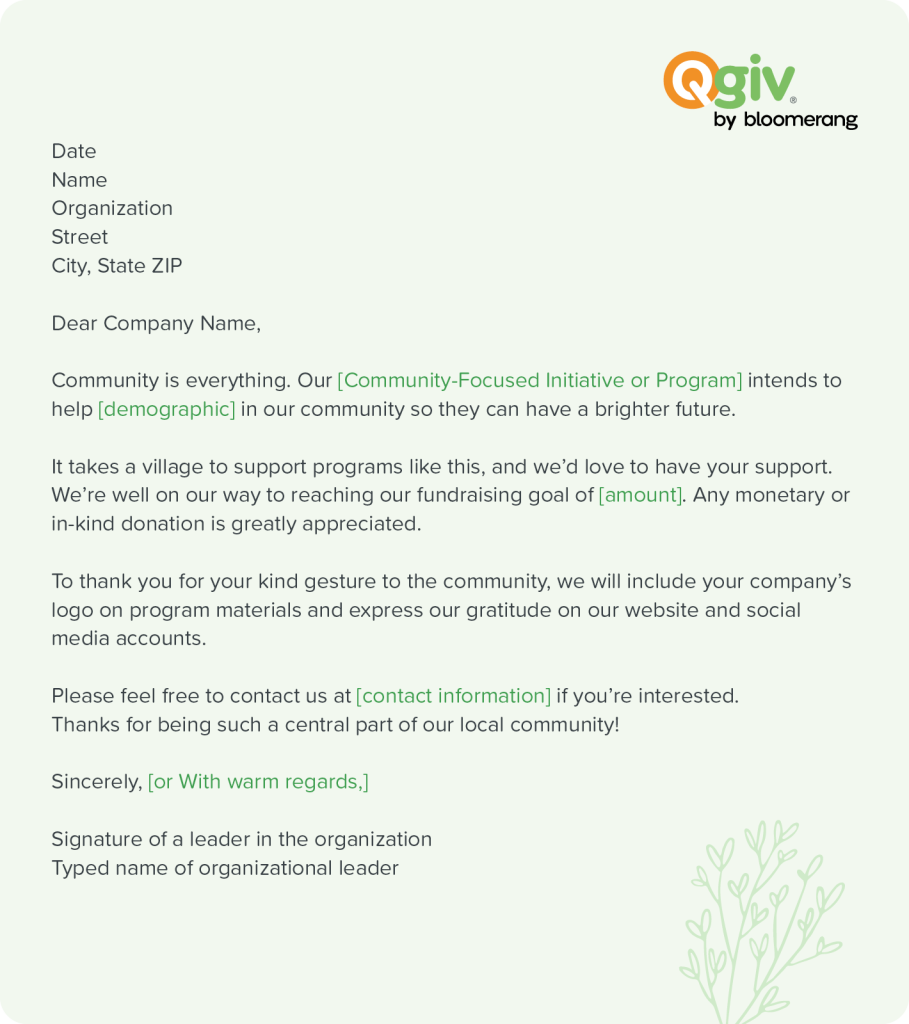
Businesses with existing partnerships and thriving CSR programs may be more likely to support a program like this. Research potential sponsors to identify companies focusing on community-building, and reach out to them accordingly.
12. Media sponsorship letter
You may run a significant event or campaign, but not have the resources to spread the word to a wider audience. In these instances, you may secure sponsorship from media outlets for promotional support, advertising space, or coverage of events.
Leverage this sponsorship letter template to form partnerships with local newspapers, TV stations, radio channels, podcasts, or social media presences:
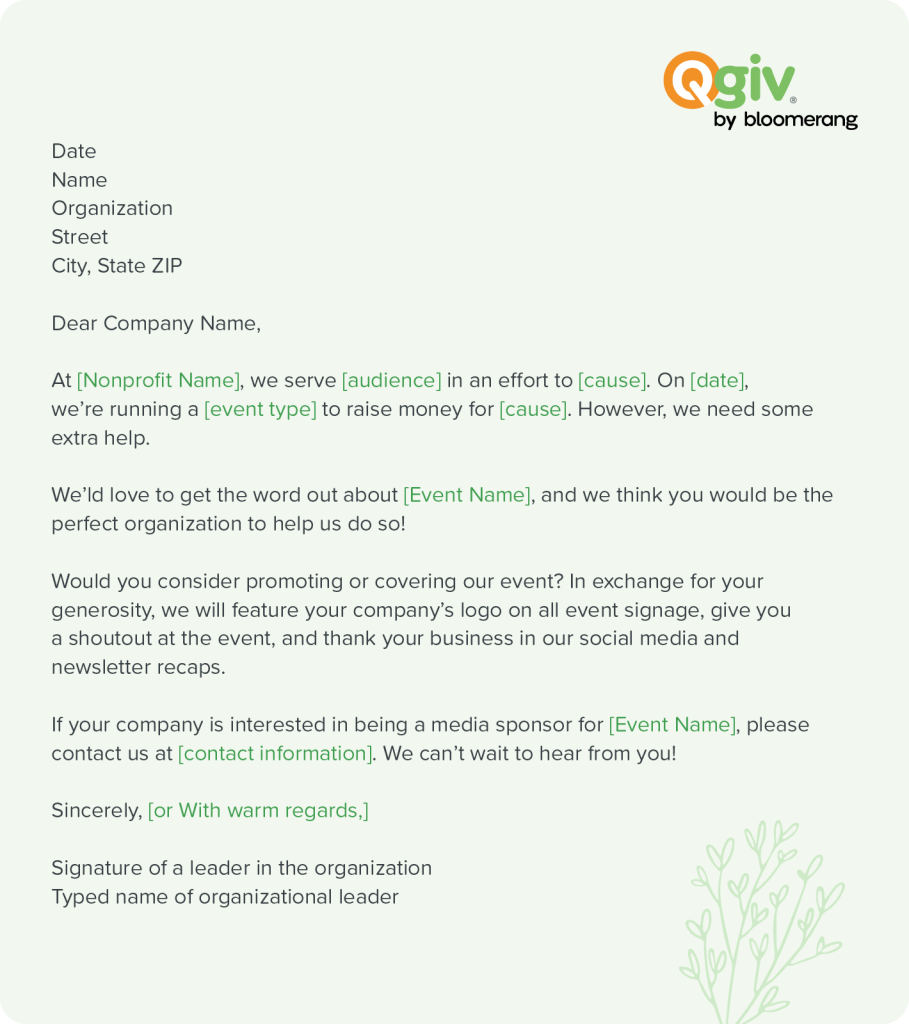
Before reaching out to potential media partners, think about your target audience. Which channels do they typically use? For example, young adults living in a city may turn to podcasts and Instagram accounts that post about events happening in their area, whereas older adults living in the suburbs may consult newspapers and radio stations more often.
13. Technology or equipment sponsorship letter
Let’s say you need a sound system for your upcoming auction but don’t have the funds to purchase one. You may request sponsorship for specific technological needs or equipment essential for your operations or programs.
These items can be very expensive for your nonprofit to buy or rent, but for companies that own or produce this equipment, it’s an easy way to show their support.
Your technology or equipment sponsorship letter may look something like this:
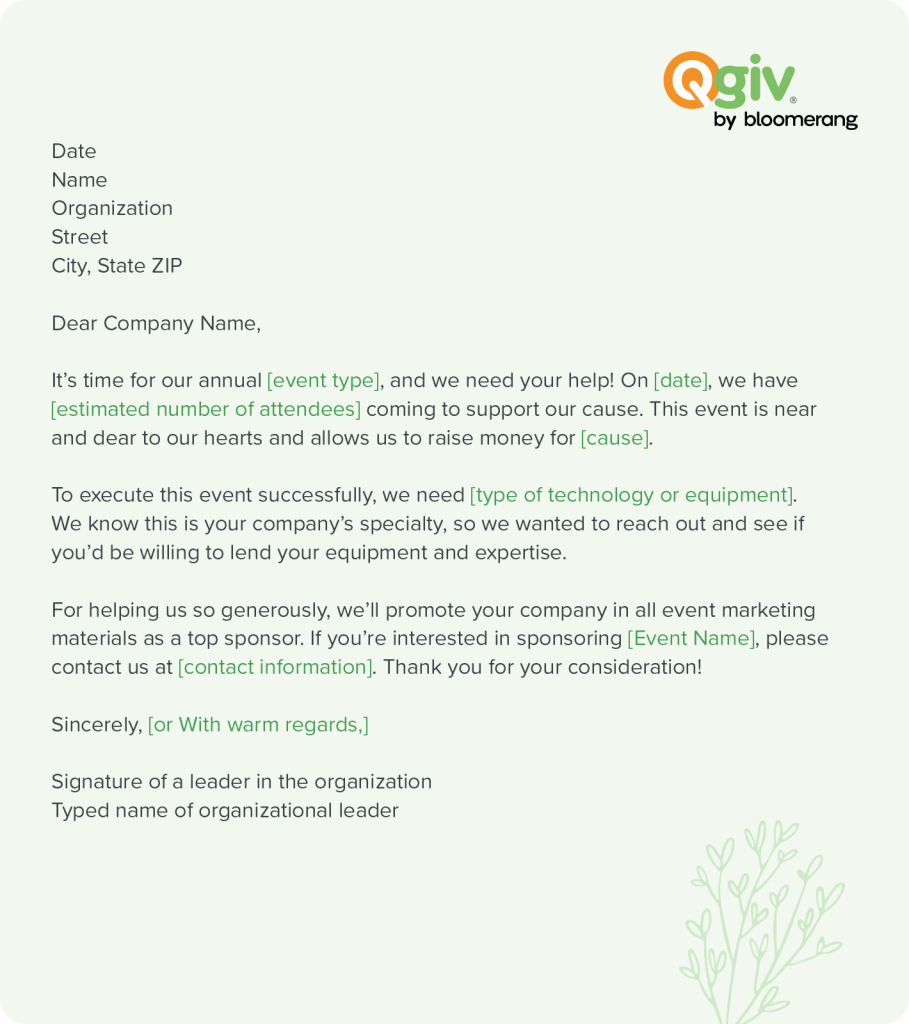
Alternatively, ask potential partners for special nonprofit discounts. That way, smaller businesses that can’t afford to offer their equipment for free can still help your organization and positively impact their local community.
14. Scholarship sponsorship letter
For nonprofits providing educational scholarships, use this type of letter to seek support from individuals or businesses to fund scholarships for deserving students. It’s best to reach out to companies with values that align with the purpose of the scholarship. For example, if you’re funding an arts-focused scholarship, you may contact art supply stores, local theatres, or dance studios.
Use this scholarship sponsorship letter template as a guide:
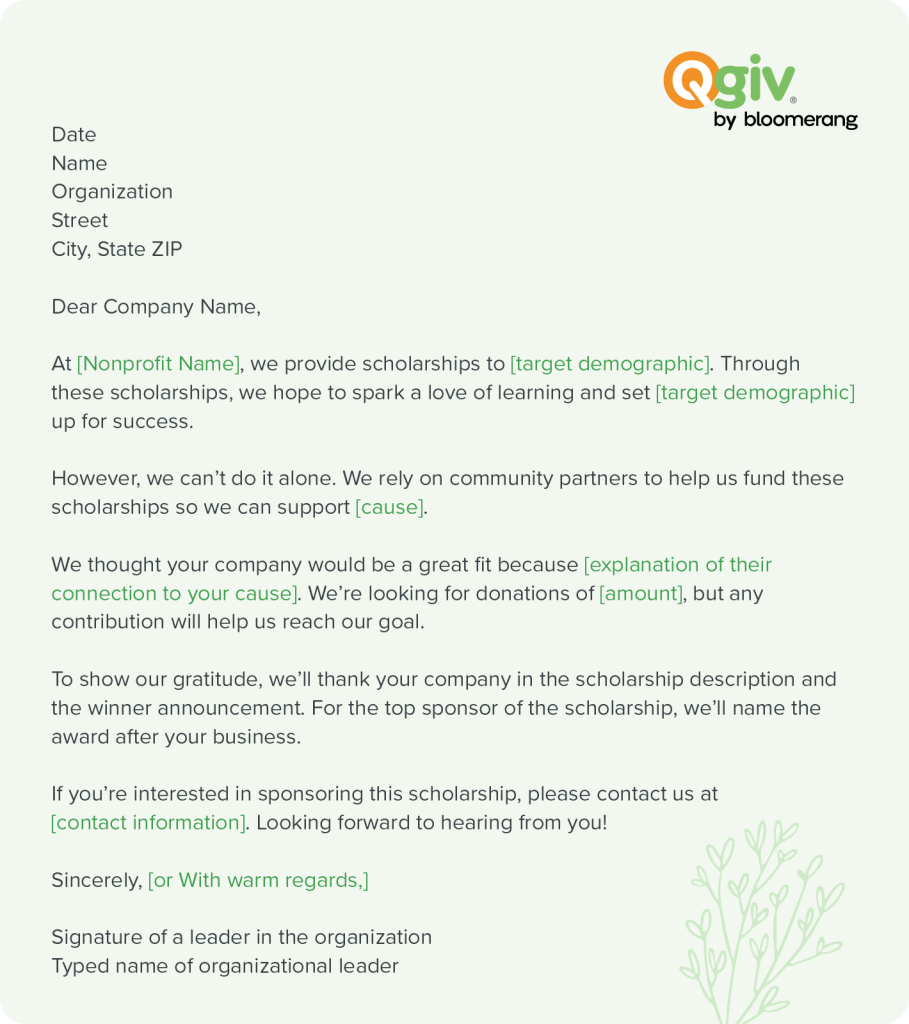
If you’ve awarded a similar scholarship before, consider including a profile of a past winner and how the funds helped them achieve their dreams. Hearing a real person’s story may inspire companies to lend their support and spark additional success stories.
15. Health and wellness sponsorship letter
If you’re running a health-focused event, program, or initiative, you may write this type of letter to contact healthcare-related businesses or organizations for sponsorship. With a shared vision of improving health and wellness within your community, you can seamlessly team up with these companies to achieve your mission.
Try sending a sponsorship letter like the one below:
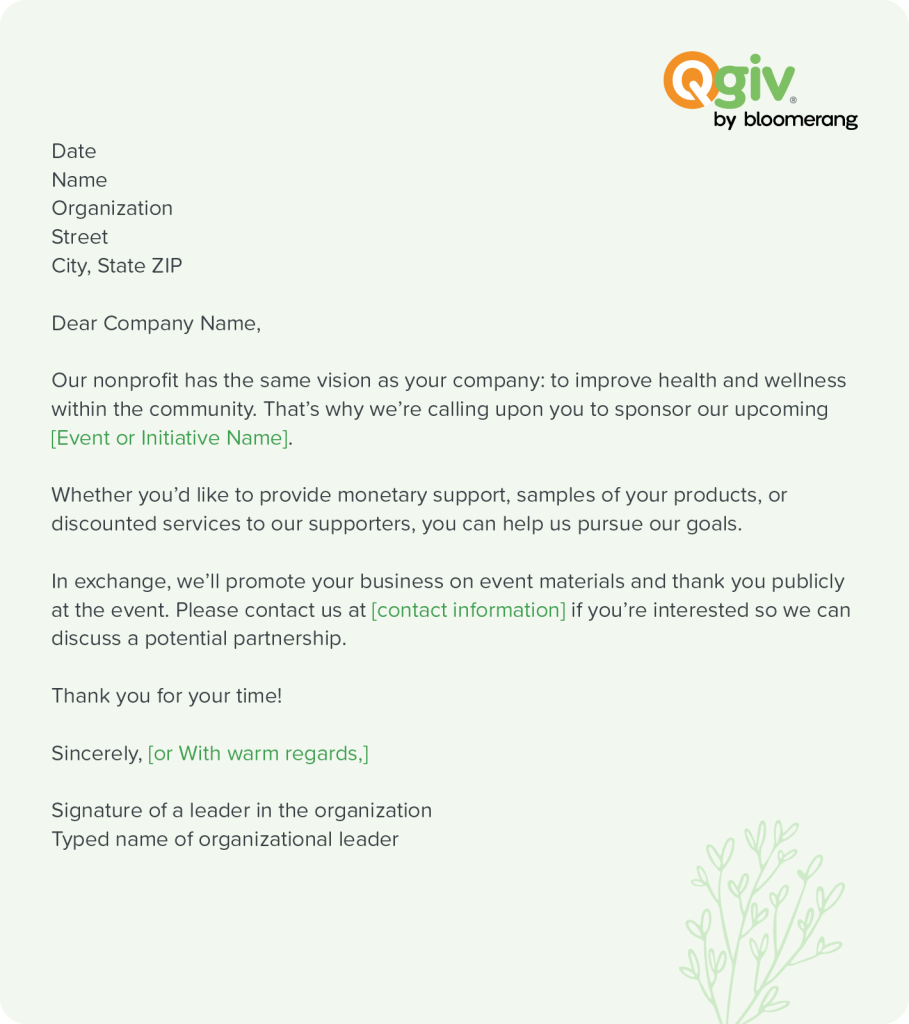
Healthcare business customers may be willing to support your health and wellness-related initiative, and your campaign’s supporters may be willing to patronize these businesses. Emphasize the mutually beneficial nature of this type of partnership for both organizations to target this niche audience.
Nonprofit sponsorship letter best practices and tips
Crafting a compelling sponsorship letter is vital for securing support from potential sponsors. It’s not just about asking for funds—it’s about building a meaningful connection and demonstrating the value of partnership. Here are some expert tips to ensure your sponsorship letters hit the mark:
- Personalize, personalize, personalize. Address the sponsor by name and ensure all personalization details are accurate. Show that you’ve done your research and understand their interests and values.
- Tailor your message. Each sponsor is unique, so tailor your letter to their goals, values, and target audience. Highlight how their support can make a tangible impact on your cause.
- Keep it concise. Respect your sponsor’s time by keeping your letter concise and to the point. Focus on conveying your message clearly without overwhelming them with unnecessary details.
- Show empathy. Put yourself in the shoes of the potential sponsor. Understand their perspective, challenges, and motivations. Frame your letter in a way that resonates with their interests and objectives.
- Include leadership endorsement. Have your organization’s leadership, such as the executive director or board chair, sign the letter. This adds credibility and shows commitment to your partnership.
- Utilize connections. If possible, enlist someone the sponsor knows to write or endorse the letter. A familiar face can strengthen the appeal and credibility of your request.
- Offer options. Provide sponsors with a range of partnership opportunities to choose from. These options could include different sponsorship levels or customizable packages to suit their preferences and budget.
- Highlight benefits. Clearly outline the benefits of sponsorship, emphasizing the value proposition for the sponsor. Whether it’s brand exposure, community goodwill, or networking opportunities, make it clear what’s in it for them.
- Include a call to action. End your letter with a clear call to action, whether to schedule a meeting, request more information, or express partnership interest. Make it easy for sponsors to take the next step.
- Thank your nonprofit sponsors. Thanking your sponsors is not just a chance to remind them of their impact. It also sets them up for future engagement down the line. And remember, you can get creative with your thank-yous as well. Who knows? Maybe they’ll want to sponsor another event or offer support in other ways!
- Follow up. Don’t let your letter be a one-off communication. Follow up with potential sponsors to answer any questions, provide additional information, and express gratitude for their consideration.
By following these best practices, you’ll increase the likelihood of securing sponsorships and forging long-lasting partnerships that benefit both your organization and the sponsor.
Other ways to promote sponsorship opportunities
Beyond writing sponsorship letters, other creative ways exist to engage potential sponsors. Leveraging additional avenues can showcase donor impact and personalize connections with your nonprofit’s mission and beneficiaries.
Explore these innovative ways to solicit nonprofit sponsorships and foster lasting partnerships:
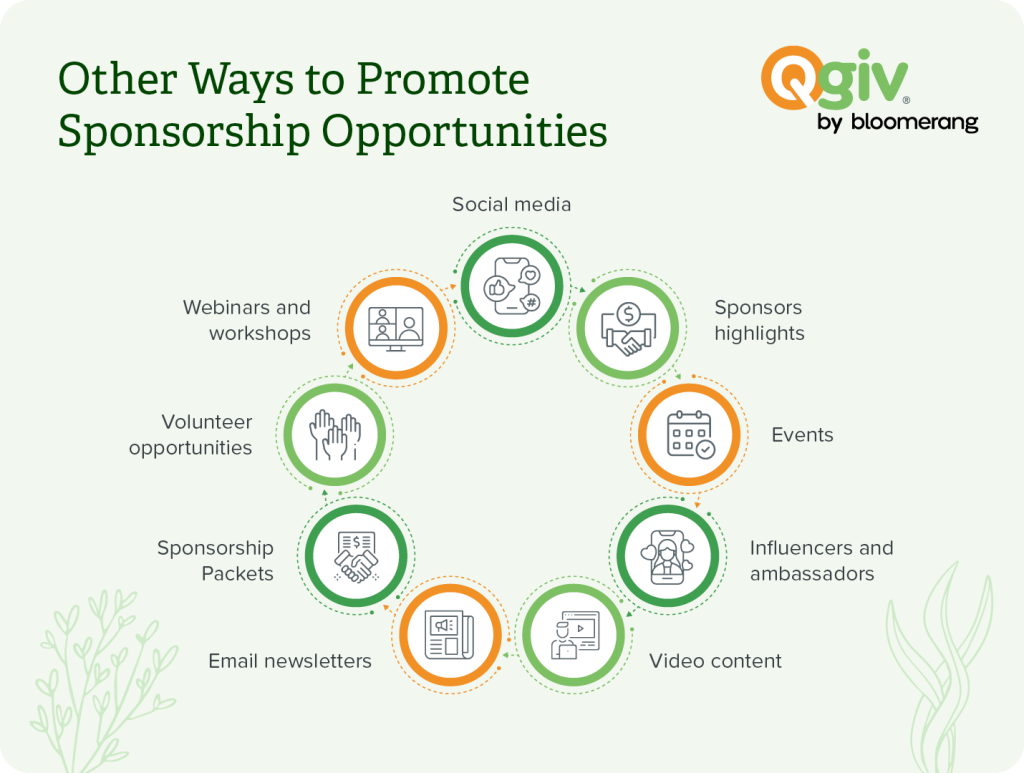
- Social media. Create engaging social media campaigns highlighting the impact of past sponsorships.
- Sponsor highlights. Showcase current sponsors’ logos or testimonials on the nonprofit’s website and social media platforms.
- Events. Host virtual or in-person events specifically tailored for potential sponsors, providing networking opportunities and insights into your work.
- Influencers and ambassadors. Partner with influencers or ambassadors who align with the nonprofit’s mission to promote sponsorship opportunities.
- Video content. Produce compelling video content showcasing the nonprofit’s initiatives and sponsorship benefits.
- Email newsletters. Utilize email newsletters to regularly update potential sponsors on the nonprofit’s achievements and upcoming involvement opportunities.
- Sponsorship packets. Offer customized sponsorship packets that cater to potential sponsors’ specific goals and interests.
- Volunteer opportunities. Provide opportunities for sponsors to engage directly with the nonprofit’s beneficiaries, fostering a deeper connection to the cause.
- Webinars and workshops. Host informational webinars or workshops to educate potential sponsors about your work and sponsorship benefits.
Just as multichannel marketing is best for promoting your nonprofit to donors, using as many channels as possible can maximize your reach to potential sponsors.
Final thoughts
Whether your nonprofit has extensive experience working with sponsors or is new to these special relationships, proposing a sponsorship to a potential partner can seem daunting.
With these sponsorship request letter templates, your nonprofit is ready to start making connections with sponsors to pursue its goals! After all, you never know when the perfect sponsorship opportunity will pop up.
Additional resources
- 12 Donation Request Letter Templates to Help Raise More. Looking to raise more money for your nonprofit? Sending fundraising solicitation letters is a good way to start. Try out these top fundraising letter templates for all kinds of causes to get inspired.
- Big Book of Hybrid and Virtual Event Ideas. Want to host more successful hybrid and virtual fundraisers? Download the eBook now!
- How Nonprofits Can Secure Corporate Sponsorships. If your nonprofit hasn’t pursued corporate sponsorship, you’re leaving money on the table. Use these tips to get started.

